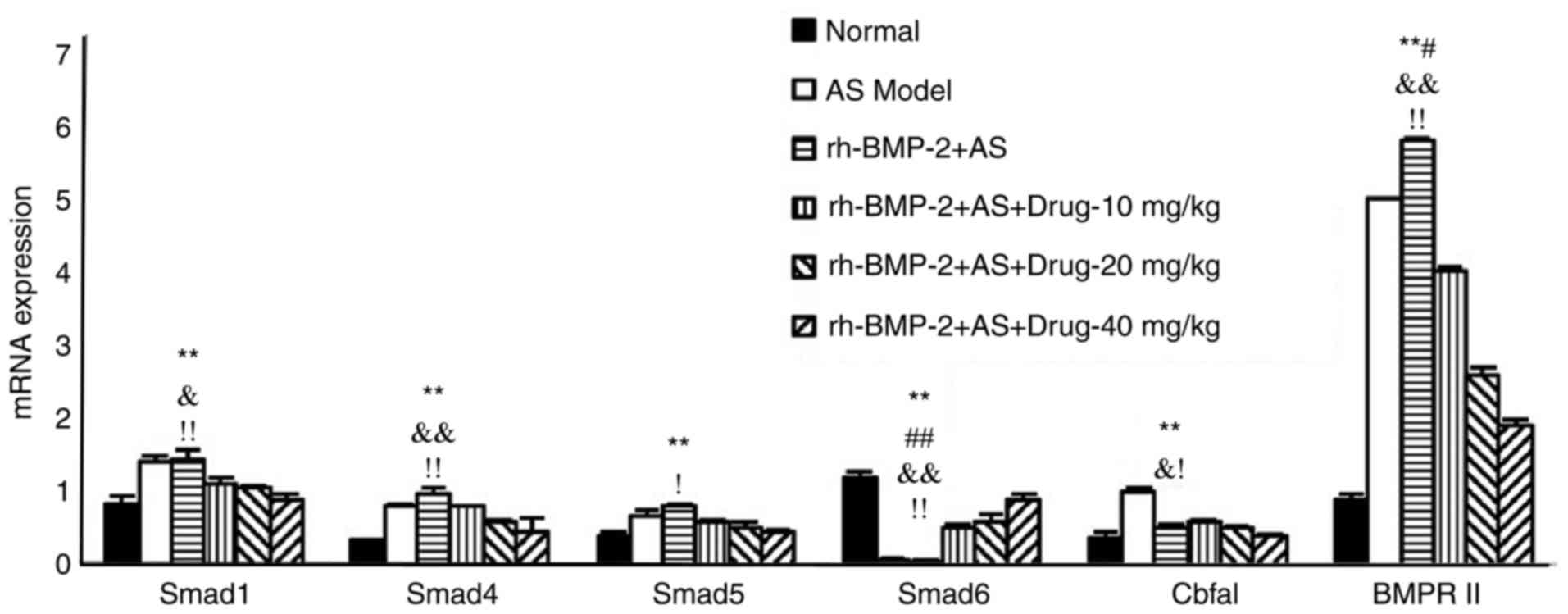|
1
|
Meyer K, Niedermann K, Tschopp A and
Klipstein A: Is the work ability index useful to evaluate absence
days in ankylosing spondylitis patients? A cross-sectional study.
BMJ Open. 3:pii: e0022312013. View Article : Google Scholar
|
|
2
|
Gerdan V, Akar S, Solmaz D, Pehlivan Y,
Onat AM, Kisacik B, Sayarlioglu M, Erhan C, Tezcan ME, Ozturk MA,
et al: Initial diagnosis of lumbar disc herniation is associated
with a delay in diagnosis of ankylosing spondylitis. J Rheumatol.
39:1996–1999. 2012. View Article : Google Scholar : PubMed/NCBI
|
|
3
|
van den Berg R and van der Heijde DM: How
should we diagnose spondyloarthritis according to the ASAS
classification criteria: A guide for practicing physicians. Pol
Arch Med Wewn. 120:452–457. 2010.PubMed/NCBI
|
|
4
|
Arends S, Brouwer E, van der Veer E, Groen
H, Leijsma MK, Houtman PM, Th A, Jansen TL, Kallenberg CG and
Spoorenberg A: Baseline predictors of response and discontinuation
of tumor necrosis factor-alpha blocking therapy in ankylosing
spondylitis: A prospective longitudinal observational cohort study.
Arthritis Res Tlier. 13:R942011. View
Article : Google Scholar
|
|
5
|
Bao J and Dai SM: A Chinese herb
Tripterygium wilfordii Hook F in the treatment of rheumatoid
arthritis: Mechanism, efficacy, and safety. Rheumatol Int.
31:1123–1129. 2011. View Article : Google Scholar : PubMed/NCBI
|
|
6
|
Qin W, Yang F, Deng R, Li D, Song Z, Tian
Y, Wang R, Ling J and Lin Z: Smad 1/5 is involved in bone
morphogenetic protein-2-induced odontoblastic differentiation in
human dental pulp cells. J Endod. 38:66–71. 2012. View Article : Google Scholar : PubMed/NCBI
|
|
7
|
Ecalco-Cruz AC, Sosa-Garrocho M,
Vázquez-Victorio G, Ortiz-García L, Domínguez-Hüttinger E and
Macías-Silva M: Transforming growth factor-β/SMAD Target gene SKIL
is negatively regulated by the transcriptional cofactor complex
SNON-SMAD4. J Biol Chem. 287:26764–26776. 2012. View Article : Google Scholar : PubMed/NCBI
|
|
8
|
Kokabu S, Ohte S, Sasanuma H, Shin M,
Yoneyama K, Murata E, Kanomata K, Nojima J, Ono Y, Yoda T, et al:
Suppression of BMP-Smad signaling axis-induced osteoblastic
differentiation by small C-terminal domain phosphatase 1, a Smad
phosphatase. Mol Endocrinol. 25:474–481. 2011. View Article : Google Scholar : PubMed/NCBI
|
|
9
|
Poddubnyy D, Rudwaleit M, Haibel H,
Listing J, Märker-Hermann E, Zeidler H, Braun J and Sieper J:
Effect of non-steroidal anti-inflammatory drags on radiographic
spinal progression in patients with axial spondyloarthritis:
Results from the German Spondyloarthritis Inception Cohort. Ann
Rheum Dis. 71:1616–1622. 2012. View Article : Google Scholar : PubMed/NCBI
|
|
10
|
Yi JF and Tang XL: The effect of
paeoniflorin, collagen, hypothalamus pituitary kidney in rats with
collagen induced arthritis. China Adrenal Axis J Pharmacol Toxicol.
27:668–672. 2013.
|
|
11
|
Wang J: Experimental study of recombinant
expression and anti-tumor effect of ING4 gene (unpublished PhD
thesis). Soochow University; 2005
|
|
12
|
Kroon F, Landewé R, Dougados M and van der
Heijde D: Continuous NSAID use reverts the effects of inflammation
on radiographic progression in patients with ankylosing
spondylitis. Ann Rheum Dis. 71:1623–1629. 2012. View Article : Google Scholar : PubMed/NCBI
|
|
13
|
Ikushima H and Miyazono K: TGF-β signal
transduction spreading to a wider field: A broad variety of
mechanisms for context-dependent effects of TGF-β. Cell Tissue Res.
347:37–49. 2012. View Article : Google Scholar : PubMed/NCBI
|
|
14
|
Thatcher JD: The TGF-beta signal
transduction pathway. Sci Signal. 3:tr42010. View Article : Google Scholar : PubMed/NCBI
|
|
15
|
Song B, Estrada KD and Lyons KM: Smad
signaling in skeletal development and regeneration. Cytokine Growth
Factor Rev. 20:379–388. 2009. View Article : Google Scholar : PubMed/NCBI
|
|
16
|
Ekman M, Mu Y, Lee SY, Edlund S, Kozakai
T, Thakur N, Tran H, Qian J, Groeden J, Heldin CH and Landström M:
APC and Smad7 link TGFβ type I receptors to the microtubule system
to promote cell migration. Mol Biol Cell. 23:2109–2121. 2012.
View Article : Google Scholar : PubMed/NCBI
|
|
17
|
Vardouli L, Vasilaki E, Papadimitriou E,
Kardassis D and Stournaras C: A novel mechanism of TGFbeta-induced
actin reorganization mediated by Smad proteins and Rho GTPases.
FEBS J. 275:4074–4087. 2008. View Article : Google Scholar : PubMed/NCBI
|
|
18
|
Edlund S, Landström M, Heldin CH and
Aspenström P: Smad7 is required for TGF-beta-induced activation of
the small GTPase Cdc42. J Cell Sci. 117:1835–1847. 2004. View Article : Google Scholar : PubMed/NCBI
|
|
19
|
Konstantinidis G, Moustakas A and
Stournaras C: Regulation of myosin light chain function by BMP
signaling controls actin cytoskeleton remodeling. Cell Physiol
Biochem. 28:1031–1044. 2011. View Article : Google Scholar : PubMed/NCBI
|
|
20
|
Chen G, Deng C and Li YP: TGF-β and BMP
signaling in osteoblast differentiation and bone formation. Int J
Biol Sci. 8:272–288. 2012. View Article : Google Scholar : PubMed/NCBI
|
|
21
|
Jun JH, Yoon WJ, Seo SB, Woo KM, Kim GS,
Ryoo HM and Baek JH: BMP2-activated Erk/MAP kinase stabilizes Runx2
by increasing p300 levels and histone acetyltransferase activity. J
Biol Chem. 285:36410–36419. 2010. View Article : Google Scholar : PubMed/NCBI
|
|
22
|
Huang Q, Zhang H, Pei FX, Chen ZY, Wang
GL, Shen B, Yang J, Zhou ZK and Kong QQ: Use of small interfering
ribonucleic acids to inhibit the adipogenic effect of alcohol on
human bone marrow-derived mesenchymal cells. Int Orthop.
34:1059–1068. 2010. View Article : Google Scholar : PubMed/NCBI
|
|
23
|
Shi XM, Blair HC, Yang X, McDonald JM and
Cao X: Tandem repeat of C/EBP binding sites mediates PPAR gamma2
gene transcription in glucocorticoid-induced adipocyte
differentiation. J Cell Biochem. 76:518–527. 2000. View Article : Google Scholar : PubMed/NCBI
|

















